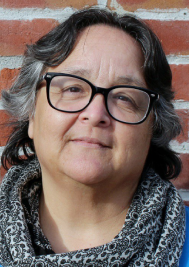Representation matters.
Whether it’s at a medical conference, governmental hearing, industry meeting, or somewhere else where decisions about diabetes care and policy are being made, inviting patients to participate is a good first step. But being in the room, in and of itself, is not enough to ensure that the many voices of people living with diabetes are heard or that disparate health needs are addressed.
This is especially true when implicit bias also has a seat at the table.
The danger of the single story
Time and again I’ve heard the same diabetes stories being shared, often by the same people. When a patient advocate is involved, they tend to be Caucasian, middle class, with access to good healthcare, and living with type 1 diabetes. These advocates talk about very real experiences: dealing with the mental load of daily diabetes self-care, the fear of complications, the cost of care, using the latest diabetes technology, etc.
While these experiences are valid, they represent a very narrow strip of diabetes experience.
In her TedTalk, The danger of a single story,Chimamanda Ngozi Adichie talks about the value of hearing many stories. When we only know one story it limits our understanding. That one story is held as the truth and assumed to apply to everyone in a similar situation.
“The single story creates stereotype and the problem with stereotype is not that they are untrue but that they are incomplete, they make one story become the only story.”
– Chimamanda Ngozi Adichie
The impact of this single story on diabetes care and policy is striking. Decision makers set out to address the problems and challenges experienced by people living with diabetes. But they can only address what’s evident. And what is evident is limited by their sources of information about life with diabetes. For example, enormous resources are put toward improving technology and developing injectables that most people with diabetes across the world will never see, let alone use.
Meanwhile the needs of the vast majority, those living with type 2 diabetes or in communities and countries with fewer resources, go unanswered. At best, their needs are addressed in a piecemeal, localized manner.
The disconnect of assuming all diabetes is equivalent
When people know only one story then all diabetes experience is seen as equivalent. This is clearly not the case and has led to some embarrassing disconnects.
In More Stories From More Voices Renza Scibilia wrote about being invited to sit on a program committee aimed at men diagnosed with type 2 diabetes in their 60s and living with erectile dysfunction—this, as a 40-something, Caucasian woman with type 1 diabetes.
This kind of disconnect happens more often than you might think.
I, myself, was invited to an industry meeting focused on type 2 diabetes a few years back. Of the twelve patients advocates attending, only three of us were living with type 2 diabetes. In the end, I’m not sure how useful the discussion that day really was for anyone involved.
In both situations the diabetes box had been ticked off. But the people involved didn’t represent the specific population or situation targeted to be addressed.
The hazard of being a diabetes unicorn
I’m a bit of a unicorn among diabetes patient advocates: a Latina living with type 2. If you only look at my raw demographics I embody a sizable community that is disproportionately affected by diabetes. At times I’ve been invited to the table to be the Hispanic representative, asked to speak for the 60 million Hispanics in the US with roots in 20+ countries and territories across the Western Hemisphere.
This is how I found myself sitting at the conference table in a private meeting room at a national conference. Surrounded by people who worked for a big pharma company that was our host. I listened as they shared how they had just engaged a new service that made their customer service available in hundreds of languages and dialects. Nearly anyone who called in could be quickly connected to a rep and translator who spoke their language.
Very impressive. Especially as the language spoken can be a major barrier to people seeking care.
Then the conversation shifted to diabetes in the Hispanic community. As the one obviously Hispanic person at the table I was asked how they could reach more Hispanics.
I took a deep breath, looked at the faces around the table and said my truth.
I told them: Don’t treat Hispanics as a monolith. The experience of a third generation Mexican American (thinking of my children) is different from a first generation Dominican. All that energy put into developing multilingual customer service, put some of that same thought and concern into approaching Hispanic communities—plural.
With that, the conversation ended. I’m not sure what they were expecting to hear. But I got the feeling that it wasn’t what I had just said.
As the meeting broke up and I gathered my things, a young man in a suit with credentials around his neck that identified him as an employee of the pharma company, walked over to me and said, “I’m Dominican.”
I didn’t know what to say. We exchanged pleasantries and went our separate ways.
To this day I wonder if his colleagues had ever asked him for his thoughts on how to reach out to Hispanics, or Dominicans. I wonder if he ever felt heard at work. Or was his mere presence in the room enough to check off their Hispanic or diversity box?
The constraints of implicit bias
In all these situations I think people were well-intentioned and sincerely wanted to make the world a better place for people affected by diabetes. Something in their thought process got in the way. That thing is implicit bias.
Implicit bias is a sneaky thing. Without being aware of it, the attitudes and prejudices we hold (both positive and negative) toward a group of people affect how we perceive and respond to groups and situations. This is the biased thinking that makes it seem okay to ask a person with diabetes to join a patient panel even though they don’t match any of the other demographic criteria. Or to ask a single person to speak to the experience of 60 million others.
Implicit bias is pervasive. These mental constructs provide a template for judging our world and the people we encounter. It is the thing that leads us to feel positively toward people like us. And the thing that leads us to feel less-than-positive toward people we consider “the other.”
Interestingly implicit bias is also malleable and can be unlearned. I’m not saying it’s easy, but there is hope that we can get beyond its limitations through conscious, concerted interventions.
The promise of inclusion
As a patient advocate I work to improve access to healthcare and health information for people affected by diabetes. Because of this I value being invited to participate in educational and policymaking events. After all, the patient must be present to be heard.
But my (and others’) experiences drive home the reality that it’s not enough to merely be present. Being present doesn’t guarantee that the patient’s voice is actually heard or valued.
To borrow a line from Harvard Public Health Review Editorial Board, our healthcare institutions and organizations “...must go beyond issues of representation to foster a culture that is inclusive.”
A seat at the table is not enough. It has to be a seat at the right table.
It’s not enough to invite diabetes patient advocates if all their experience represents only covers a narrow strip of the overall diabetes community. It’s not enough to invite just any old person with diabetes when that person doesn’t represent the sub-community trying to be helped.
It’s not enough to hire people of color in healthcare, if they aren’t given opportunities to speak their truth or if they are not listened to and given the same consideration as the predominating ideas.
We have to look beyond the usual suspects for people who, collectively, can better represent the vast diversity of lived experience and expertise in diabetes.
We have to value what people say, think, and suggest. Even if it’s uncomfortable or contradicts what we think to be true. This is especially true when asking people to share their personal information and experiences. There is nothing more soul crushing than being asked to tell your life story only to have it be dismissed or contradicted—or pitied.
We have to go beyond the invitation and consider the impact the presence of patients in the conversation can have. Then we need to foster a welcoming environment that accepts and values the experiences shared by people. From here diabetes care can be better informed by the many experiences of the people directly affected.
Anything less is not enough.



